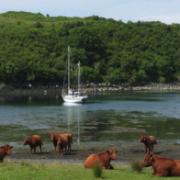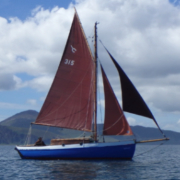
CNYC Meeting Archive – Year 2020
As we all know, the last 2 years activities have been on-hold for all clubs, associations and societies, and Chipping Norton Yacht Club has not been spared.
We did get started in early 2020 and enjoyed to two excellent meetings.
Then Covid hit the UK and our activities were put on hold.
Below are reports of those first presentations given as normal after a fine supper...
January 2020
Sam Llewellyn
Adventures in the Gulf Stream
Sam is a natural raconteur with a dry humour that many of us know from his articles in Practical Boat Owner, republished in “The Minimum Boat”. If you haven’t read it, do. It is as funny as “Three men in a Boat” but more useful to us who are into boats.
humour that many of us know from his articles in Practical Boat Owner, republished in “The Minimum Boat”. If you haven’t read it, do. It is as funny as “Three men in a Boat” but more useful to us who are into boats.
As Sam explained, the Gulf Stream (long may it flow!) has an extraordinary effect on the climate of our west coast, allowing plants of the kind one would normally only expect to see in the tropics, to flourish, up to latitudes close to that of Moscow. The start was accidental. Logs brought back from Australia, as ballast to Falmouth, sprouted. An idea was born.
Sam was borne in the Scillies. The family once rooted there included his great-great-Uncle, Augustus John Smith, who had owned them (having acquired them under a lease from the Duchy of Cornwall, in 1834). Sam didn’t tell us this in so many words, as he is a modest man, like his Aunts*. The great-great-Uncle was mentioned in the context of having founded, on Tresco, one of the tropical gardens that were the focus of Sam’s talk. This Uncle was a philanthropist and avant-garde educationalist - it being notable that most of the male alumni of the schools he started went to sea to become officers, and very few of the female alumni went into service. Extraordinary, in its day.
Over the years, many ships and lives have been lost on the rocky coasts of the Scillies and Augustus built up the “Valhalla collection” of about 30 ships’ figureheads, name boards and other ships’ carvings from shipwrecks – mostly of small merchant vessels - that peppered the coastline there.
So Sam talked us through a sea passage, sailing from Falmouth, avoiding the treacherous Manacles rocks off The Lizard peninsula, up the west coast of the British Isles, through the dreaded Irish Sea, to Scotland and its Isles, visiting many of the gardens along the coast and on the islands. He interposed pictures of the lush gardens with pictures of the sea, harbours, bird life, and the boats he’d visited them in.
The boats (idiosyncratic all) included an open Drascombe Longboat with a tent on top, a little gaffer (a Cornish Shrimper), a raised-from-the dead Corribee, and finally in an (also raised-from-the dead) Deep Seadog - a bigger, competent boat that does not challenge the aesthetic of the others. To put it kindly.
Sam brought along, as authors do, a selection of his works to autograph and sell. These include his sailing thrillers, and a book with a garden focus “Digging with the Duchess”. I am glad to report he did a good trade. It was great to see and hear from him again!
*Aunts - when last at the Club Sam told us of his Aunts, who had sailed round the world but hadn’t told anybody as they would have thought that was showing off.
February 2020
Julian and Alison Cable
The West coast of Ireland
Julian and Alison Cable took turns to recount their a voyage round Ireland, in a small and elderly little yacht. They started by emphasising that this was not a single trial of endurance - they had avoided long passages, night sailing and bad weather by leaving the boat and flying home after each of the many stages of the trip.
recount their a voyage round Ireland, in a small and elderly little yacht. They started by emphasising that this was not a single trial of endurance - they had avoided long passages, night sailing and bad weather by leaving the boat and flying home after each of the many stages of the trip.
The talk concentrated on the lesser known and, for us yotties, more scary voyages along the exposed western Atlantic coast where seas are big and harbours and refuges are few and far apart.
Their very pretty (22’6”) boat Robinetta was built in 1937 and designed by D.A. Rayner, who went on to design the very successful Westerly 22 which marked the start of Westerley Marine’s commercial success and long run as leading British yacht builders. Robinetta, a traditional gaffer, was slow but comfortable - and with her sea-kindliness and TARDIS interior, looked after them well. As they said “failure is allowed” and their aim was to be adventurous, not intrepid. They worked the weather, worked the tides, and most importantly did copious homework on harbours of refuge so they could always dash for safety when need arose - not feeling bad when they did but rejoicing in finding a new place to explore. Often the harbour was a small commercial port where they met friendly people to admire their boat and join them in raising a glass.
Interspersing the dramatic pictures of jagged rocks, craggy cliffs and havens were pictures at sea looking back at their little wooden dinghy Worms serenely following them at the end of a painter. Worms is an Iain Oughtred design (a “Mouse”) that Julian had made.
A heart-warming talk well suited to a chilly winter evening!
October 2016
Dick Durham
Confessions of a Cruising Correspondent
 Dick Durham served on the last working Thames barge before writing for national newspapers and sailing magazines. He joined Yachting Monthly in 1998 as Feature Writer and News Editor and has travelled the globe in search of sailing stories. Still a big part of the magazine, his role is now Editor at Large.
Dick Durham served on the last working Thames barge before writing for national newspapers and sailing magazines. He joined Yachting Monthly in 1998 as Feature Writer and News Editor and has travelled the globe in search of sailing stories. Still a big part of the magazine, his role is now Editor at Large.
Dick opened by telling us that the East Coast was the “third world of yachting “ and proceeded to entertain us with recollections, history and anecdotes covering boats he’s sailed or owned, foul-ups he and others have made, and the skippers and crew he’s sailed with. He did the voices, and had many of us laughing out loud (a rare event at the Chipping Norton Yacht Club). The coast, from the Humber to Dover, has 13 rivers, 60 creeks, a multitude of swatchways, and a vast number of wrecks to testify to the challenges some skippers had failed to rise to. There are hundreds on The Goodwins alone.
We who sail more-or-less modern boats forget that for a long time sailing boats had no engines. If wind failed and the anchor work was not brisk the tide would take you where it would. Perhaps into the side of an anchored naval vessel being painted at the time, a job not improved by an applique of hay, stuck to the wet paint.
Dick told us of the Deal boatmen who had fistfights on the beach over salvage disputes, of a brandy barrel that was found to be surprisingly heavy after all the brandy was drunk (owing to the dead monkey). He told us of Black Tail Spit (the East Coast Cape Horn), and of a horseman rescued from his swimming horse, which had to be tied alongside as no one could work out how to get it aboard. He showed us pictures of some of the wrecks, beacons, derelict Mulberry harbour components, towers and other strange structures that punctuate these swirling waters.
Most memorable was the reading from the Seagull owner’s manual that had many of us laughing rather hysterically. This very serious, rather pompous, and long-winded bit of prose announced that there were two sorts of Seagull owner - the sort that had no problems and the sort that had them in spades. It was absolutely no fault, it implied, of Seagull or the design or quality of its engines, that you were one of the problem-attracting set. You really should snap out of it.
Over a drink after the talk one of us asked Dick whether he could help us get a few words about our club into Yachting Monthly, and he said he’d be happy to receive something. Unfortunately (or fortunately) in the following week he told us he’d already written it. So keep an eye open for this in YM, around Christmas. We did stress to him he should not assume that Chipping Norton Yacht Club members had anything to do with the notorious Chipping Norton Set. We’ll see.